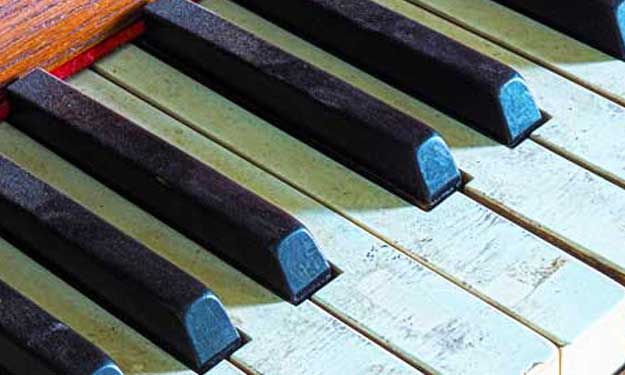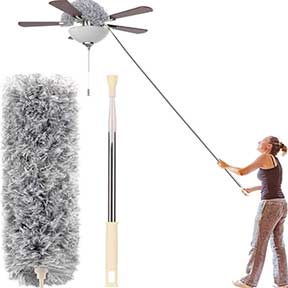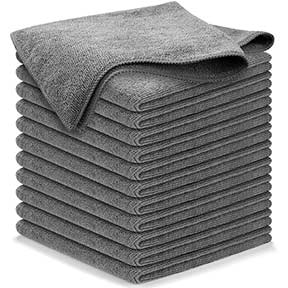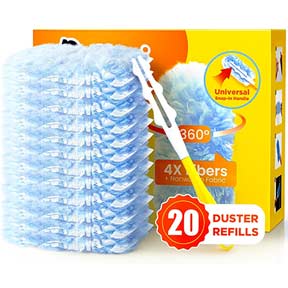How to Dust Your House

How to Dust Like a Professional House Cleaner
Professional Dusting Tips: Ceiling to Floor
It’s a beautiful day and the sun is finally shining in the Pacific Northwest. The birds are chirping and, as I look across my room out the window I notice not only the birds at the feeder but – my dirty windows and all the cobwebs in my home. I look closer and see a light layer of dust on the table by the window. Now I am getting a little bothered – even though I am the owner of a house cleaning company, the sun has pointed out once again that I cannot totally eliminate dust and dirt from my home. To help you keep dust to a minimum in the house, we’ll show you how to dust your house.
Dusting isn’t hard itself; it’s all about the process and making sure that you don’t go throwing dust all around. So, let’s get busy dusting and I’ll show you too, so you can dust just like a professional house cleaner too!
What is Dust Anyway?
It’s not a pretty picture at all. I used to think dust was just harmless lint floating on the breeze. Well lint is part of it, but there are other things that make up dust; namely dead skin cells, insects and insect feces. No wonder people are allergic to dust!
- Lint
- Dirt
- Dead skin cells
- Dead dust mites
- Dust mite feces
- Pollen
- Smoke or pollution
Do You Have Dust Allergies?
Before starting: Use a small face mask to cover your nose and mask if you are sensitive to dust. Dusting even what looks to be a very clean house will stir up dust and it’s better not to breathe it.
Longer term: Once you get the dust under control you can help keep the dust at bay by using a HEPA Air Filter. A HEPA filter reduces free floating dust in the air, not only making the air cleaner, but reducing build up so you won’t have to dust as often.
Every so often you take the filter out to the front porch or to the bathtub and literally hose out the removable filter.
1. Put All Clutter Away
It used to take me hours to dust and I just dreaded it. Then I learned a valuable lesson: put clutter away before dusting.
Sounds like common sense, but I know when I was younger my focus was getting the job done and over. Now I focus on efficiency and quality. So, before you get started:
- Pick up everything on the floor and other surfaces.
- Put everything in its place in the room you are dusting.
- If you get sidetracked easily: use a basket to place items that belong in other rooms so you are not running all over the house. You can put the items away later.
Having less clutter in the room to clean and dust will make the job faster and easier. The result is a great looking room that is both clean and clutter free!
2. Pick Up and Shake Rugs, Runners and Pillows
Now that you have the area picked up, grab any throw rugs or hallway runners and take them outside. You’ll need to shake these out before moving ahead with dusting.
Smaller rugs and runners
- Pick up a rug and take it outside.
- Move away from the front door and walkway and shake it out. It is best to shake your rug on a grassy area so you don’t track the dust and debris that you are shaking out back into the house.
- If you have a fence, lay the rug over the fence to air out and keep it out of your way or if it is a washable rug, throw it directly in the washing machine.
- Do this with all rugs in the room you are dusting.
Large area rugs
- Large rugs are too hard to move outside, so instead just vacuum the rug.
- Roll it up and move it out of the room.
Couch and Pillows
Some people forget this step, but if you want to do a thorough job and cut down on future dust build up, you’ll want to remove all the dust you can from your couch and pillows.
- Take pillows outside and fluff and shake to get the dust out.
- If the pillows are washable, go ahead and throw them in the wash; if not, find a place to store them temporarily while you finish the rest of the couch.
- Now remove all couch cushions and do a thorough job of vacuuming-you will be amazed at all the “stuff” you will find!
- Vacuum each cushion and replace.
3. Assemble the Dusting Tools
We have learned what cleaning tools work best for dusting and we have learned what to avoid.
Tools to Use:
- Static high duster: Static high dusters to remove cobwebs, dust walls and corners, chandeliers and ceiling fans.
- Damp cleaning cloths for most surfaces: Cotton cleaning cloths are fairly inexpensive and very effective for areas that have heavy dust.
- Microfiber cleaning cloths: Microfiber cleaning cloths can be of benefit when dusting glossy or areas of high shine (like mirrors) because they don’t shed lint like cotton cloths tend to do.
- Swiffer duster: For uneven surfaces or surfaces that you don’t want to use any furniture polish or glass cleaner on, Swiffer dusters are efficient at removing dust. They are fluffy and are lightly treated to attract dust. They are also flexible enough to get in tight places.
- Vacuum: We use vacuums with HEPA filters. This makes it so that 90+% of dust is trapped in the machine. Your vacuum exhaust is cleaner meaning that virtually no dust will be exhausted back into the air.
Tools to Avoid:
- Feather dusters: Some people use feather dusters, but they just move dust around and don’t pick it up, so you’re just moving the problem to another area.
Extra Efficient Cleaning Tip
- Mr. Clean Magic Eraser: When you’re dusting doors or windowsills (or any trim for that matter) you will undoubtedly run across smudges from hands or whatever. After dusting, a magic eraser comes in handy to go over these smudges.
Now that you have your dusting tools, lets get busy and get the job done!
4. Dusting Guidelines
- Dust systematically: Make a plan and follow a specific route through your home to be sure that you dust everything.
- Start at the top and work your way down: This means get the high corners and cobwebs first, then hit the top of the picture frames, dust the picture, then down the wall and dust the baseboards last.
- Move in one direction only and make your way around the room. Either right to left or left to right. The objective is to be efficient and only touch something once rather than zigzagging about.
- Clean your dusting cloth regularly or get a new clean one if the old one gets dirty. I like to have a stack ready before I start – it makes it much easier to grab and keep going.
- Do a once over: Look for the areas in the room you might not notice or clean regularly – corners are the places I tend to miss.
5. Step-by-Step How to Dust
It is totally optional to turn on some music, but it really gets me moving when I dust. With music, it doesn’t seem so much like a chore and it keeps me focused and in “the zone”. Oh what the heck – crank it up.
Now let’s take care of the dust:
- Start at the top of the ceiling: Use a Swiffer duster or your vacuum wand (with brush attachment) and work your way around the room and get rid of spiderwebs, cobwebs and dust at a high level such as tops of cabinets.
- Dust light fixtures and the light bulbs. Make sure the light bulbs aren’t on or hot when you dust them. If you really want to do a thorough cleaning, remove the globes and place them in a sink to wash later. Dust the light bulbs.
- Move down the wall: Now it is time to dust the top of bookcases, your picture frames, light switches and window frames. The tops of all these items can be easily missed and they are definitely dust collectors.
- Dust the doors: Clean and dust the doors making sure to dust the top of the molding. You may want to clean off any fingerprints or black marks. Use a magic eraser to remove marks quickly and easily.
- Vacuum the drapes: Drapes are dust magnets! Use your drapery attachment and go over your drapes thoroughly. I try to do both sides top to bottom.
- Dust mini-blinds: If you have blinds, now is the time to remove dust so it doesn’t build up.
- Dust all of the furnishings. Use a good quality furniture polish to shine and remove fingerprints. Dust all tables and chairs with the dusting cloth. Don’t forget to dust the legs of the furniture too.
- Wipe down the entire flat surface, then the items. I like to remove all items on a table, dust the surface then clean each item and replace. Resist the urge to “scootch” items to one side and dust one side at a time. It is not efficient and will just move dust around.
- Don’t forget kitchen appliances and the TV and stereo equipment: These items attract dust and can be damaged by buildup. Clean the tops, back, front and sides.
- Dust behind things: The back of the TV and book cases are usually caked with dust. I like to use a static duster to clean up this heavy build up
- Clean the base boards and trim. I like to use the brush attachment of the vacuum. It will do a great job unlike the vacuum wand that leaves a black mark behind. You can also use a cloth, but it is more labor intensive.
- Last step: Vacuum the carpets completely. This means going back and forth to cover the carpet in all directions. This helps pull out the dust and debris that has fallen down from the walls and furniture back out of the carpet. When it comes to vacuuming the carpet, you need a high quality cleaning machine that has a good filtration system.
6. Replace Rugs, Runners and Pillows
- Wash and replace rugs
- Wash and replace pillows
- Wash and replace light fixtures
7. Congratulations!
Now that you’ve dusted the house, you should notice that your room is much cleaner and will stay that way much longer. After following this routine a few times, it will become easy and you will cut your time down while knowing that you are doing a much more thorough job.
With the right process and the right tools, dusting is a breeze. Now open the windows let in some fresh air and pat yourself on the back for the great dusting job you’ve done. We can worry about cleaning those dirty windows tomorrow.
Shopping List











